
The volcano, Mt Popa, is the home of the nats, with Taung Kalat,
a Buddhist monastery on the small mountain to the left
Copyright 2011, all rights reserved, by Bob Frazee



I have discussed the two major religious practices in southeast asia, Hinduism and Buddhism but you also have to be aware of a third spiritual belief which is very much a part of the spirtual life of people living in Myanmar (Burma) - the nats.
The nats are spirits worshipped in Burma (Myanmar) in conjunction with Buddhism. They are divided between the 37 Officially designated Great Nats and all the rest (i.e., spirits of trees, water, etc). Almost all of the 37 Great Nats were human beings who met violent deaths (refered to as "green death"). They may thus also be called "nat sein" (green spirits). Much like sainthood, nats can be designated for a variety of reasons, including those only known in certain regions. Nat worship is less common in urban areas than in rural areas, and is practised among ethnic minorities as well as in the mainstream Bamar society. It is however among the Buddhist Bamar that the most highly developed form of ceremony and ritual is to be seen.
The widespread traditional belief among rural folks that there are forest guardian nats (spirits) and mountain guardian nats (spirits) appears to act as a deterrent against environmental destruction up to a point. Indiscriminate chopping down of particularly large trees is generally discouraged because of the belief that they are dwellings of tree spirits and that such an act would bring the wrath of the nat upon the perpetrator.
The most important nat pilgrimage site in Burma is Mount Popa, an extinct volcano with numerous temples and relic sites atop a mountain 1300 metres high, located near Bagan in central Burma.
Nats have human characteristics, wants, and needs. They are flawed, having desires considered derogatory and immoral in mainstream Buddhism. During a nat festival, during which nats are propitiated, nat mistresses or mediums dance and embody the nat's spirit in a trance. The roles of nat mistresses are often fulfilled by transvestite men. Music, often accompanied by an orchestra, adds much to the mood of the nat festival, and many claim to be entranced. People come from far and near to take part in the festivities in various nat shrines, get drunk on palm toddy and dance wildly in fits of ecstasy to the wild beat of the saing music, convinced that they have become possessed by the nats.
Whereas nat festivals are annual events celebrating a particular member of the 37 Nats regarded as the tutelary spirit in a region, with familial custodians of the place and tradition, and in ancient times with royal sponsorship which included evocative of royal rituals, there are also neighborhood nat festivals (nat "kannahs") where individuals would have a pavilion set up in a neighbourhood and the ritual is generally linked to the entire pantheon of nats. The nat mistresses as an independent profession made their appearance in the latter half of the 19th century as spirit mediums. Neighborhood festivals are more of an urban phenomenon which have evolved to satisfy the need of people who had migrated from the countryside to towns and cities but who wished to carry on their traditions of paying homage to the tutelary spirit of their native place.
Background: King Anawrahta of Bagan (1044-1077) tried to enforce a ban on nat worship. When he was unsucessful he designated an official pantheon of 37 Nats and incorporated them into Buddhist worship. His stratagy was to bring the nats to his Shwezigon Pagoda in positions of worshipping the Buddha. By placing Thagya Min, king of the nats, at the head of the pantheon, above the Mahagiri nats, he eventually succeeded. Seven out of the 37 Nats appear to be directly associated with the life and times of King Anawrahta. The official pantheon is made up predominantly of those from the royal houses of Burmese history, but also contains nats of Thai and Shan descent.
I am listing only the more notable so you can understand the cause of their "violent deaths".
Hnamadawgyi or Royal Sister. Her given name was Saw Me Ya, the elder sister of Maung Tint De. She became the queen of the King of Tagaung. When she saw her brother being burned alive, she leapt into the fire, but only managed to save his head. She died of her burns and became a Nat. She is portrayed standing on a dais upon a black elephant, her right hand on her chest with a plum between her thumb and index finger, and her left hand by her side.
Shwe Hpyin Naungdaw(Inferior God the Elder), and
Shwe Hpyin Nyidaw (Inferior God the Younger), together known as "Brothers" or "Brother Lords", were sons of Byatta, the royal messenger, and Me Wunna, a flower-eating ogress from Mt Popa, during the reign of King Anawrahta of Bagan. They were killed for neglecting their duty to provide a brick each thus leaving gaps in Taungbyone Pagoda, which was built by King Anawrahta. They are portrayed on pedestals, one lying down and the other upright with his sword shouldered arrogantly. Their mother, Me Wunna, died of a broken heart after their father, Byatta, was killed. She became a nat known as Popa Medaw (Mother of Popa).
Thonbanhla (Beautiful in Three Ways) was a native of a Mon village called Takunnwan. She was "beautiful in three ways within one day." She was given to King Duttabaung of Pyay, but the queen was jealous of her beauty and told the king that Thonbanhla was actually very ugly and so fat that she could not fit through the city gate. Hearing this, the king refused to marry Thonbanhla who then died in despair. Another story says that she was the younger sister of Maung Tint De (Mr Handsome). She married King Samim Htaw Yama of Utthala and gave birth to a daughter, Shin Mi-hnè, but then died of a sudden illness. She is portrayed standing on an ogre bending over a dais supported by an elephant. She wears a topknot, her right hand on her chest and her left hand by her side.
For more information about our travels write to

![]()
Nat Worship and Ecology

![]()
Popular Nat Festivals
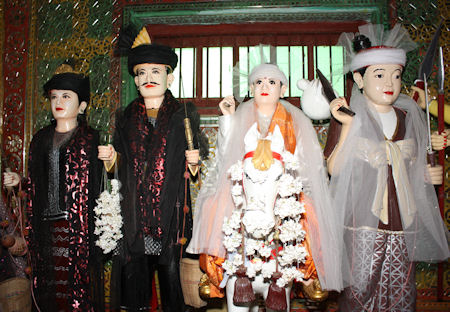

![]()
List of Official Nats
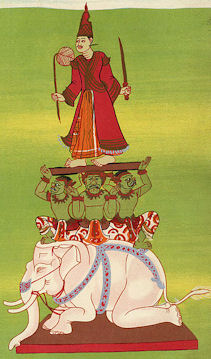
Shwe Nabay was a beautiful woman of Mindon Village who married a Naga. Later, her husband deserted her and she died of a broken heart. Another story maintains that she was actually the wife of Maung Tint De (Mr Handsome). She is portrayed standing, wearing Naga headdress, her right hand on her chest and her left hand by her side.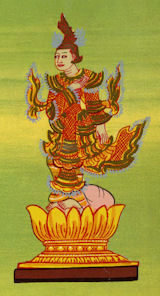
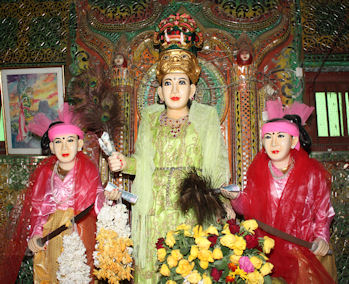
Me Wunna with her sons Min Gyi and Min Lay
Popa Medaw (aka Me Wunna) (Royal Mother of Popa), who according to legend was a flower-eating ogress called Me Wunna, lived at Popa. She fell in love with Byatta, whose royal duty was to gather flowers from Popa for King Anawrahta of Bagan (1044–1077). Byatta was executed for disobeying the king who disapproved of the liaison, and their sons were later taken away to the palace. Me Wunna died of a broken heart and, like Byatta, became a nat. Their sons also became heroes in the king's service but were later executed for neglecting their duty during the construction of a pagoda at Taungbyone near Mandalay. They too became powerful nats but they remained in Taungbyone where a major festival is held annually in August.
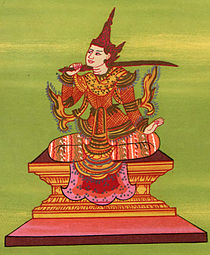
Maung Po Tu, a tea trader during the reign of King Minkhaung of Innwa, was killed by a tiger on his way to Shan state. He is portrayed sitting on a tiger, a stick in right hand and left hand on his thigh.
![]()
![]() Belli.
Belli.